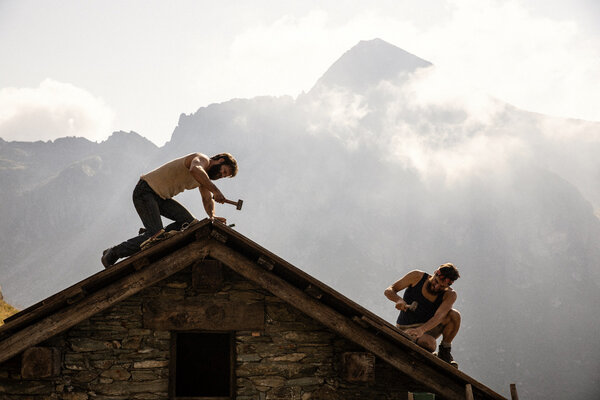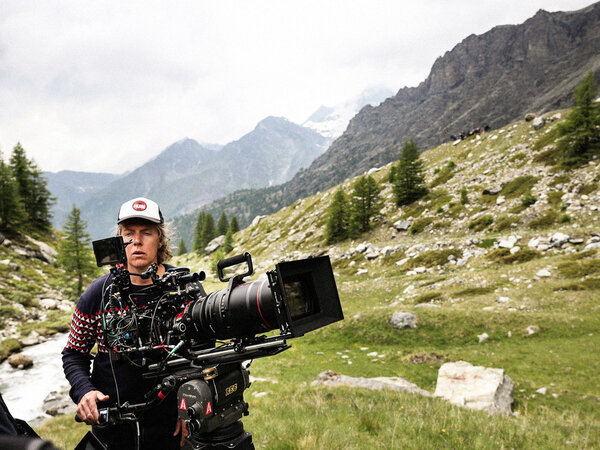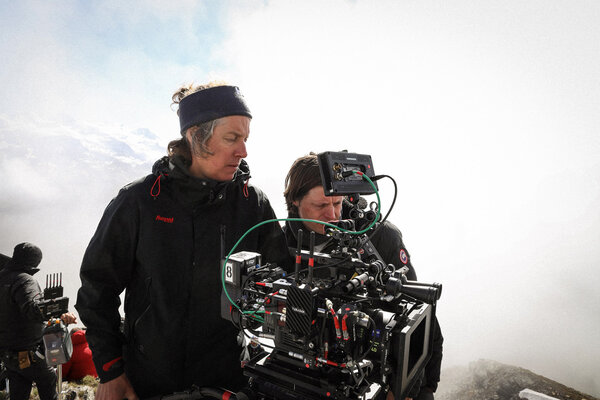Festival de Cannes 2022
Ruben Impens, SBC, discusses the making of "The Eight Mountains" by Charlotte Vandermeersch and Felix Van Groeningen
From the novel to the screenPietro is a city boy ; Bruno is the last child living in a forgotten village in the Valle d’Aosta. They become friends in this hidden corner of the Alps which serves as their kingdom. Life puts distance between them but is unable to separate them completely. While Bruno remains faithful to his mountain, Pietro travels the world. This journey will bring them knowledge of love and loss, their origins and their destinies, but most of all, a friendship through life and death.
How did you become acquainted with The Eight Mountains ?
Ruben Impens : Well, I had already read the book before Félix and Charlotte spoke to me about the film. My first reaction, when they told me about the project, was “but how are we going to manage to do that ?!” It seemed to me that it would be’ a really difficult book to adapt. Even though I’d loved it, I felt like there was really too little action in it to consider making a movie out of it. I think I must have told them it was a really good idea, and wished them good luck, with a bit of irony. It was like walking on a very, very fine tightrope over the abyss.
Did you take a long time to scout the locations ?
RI : We immediately began pre-production. That involved meeting Paolo Cognetti, who is a fascinating character. He lives in a mountain village called Estoul, where he set his latest novel. It’s a tiny place with a restaurant and a guest cabin… no more than 20 houses. You run into him with his dog and everyone knows each other, of course. When we visited the mountain, we began to ask ourselves basic questions that emerge out of the screen play, such as how we’d best be able to manage the logistics given the different mountain locations required. We also developed a shooting schedule that would begin in spring 2021 and might last until winter. Everything fell into place concretely when we chose the alpine house. This location was accessible via a track, off of which we branched out to find the other locations on the film. A helicopter was still needed to make rotations on the highest locations and spare us long hours required to reach these locations on foot.

The film is in harmony with the rhythm of the seasons…
RI : When you discover the Alpine environment, and really begin hiking, you quickly realize that time slows down in a certain way. You can no longer do so many things as you are used to in a city, and the notion of taking one’s time kind of settles in by itself. The time we spent scouting, visiting the many locations planned, logically put us in a placid sort of rhythm. The film was supposed to take its time to tell the story. That was obvious. In parallel to preproduction, both technical and logistical, the actors, and especially Luca Marinelli, spent time hiking with Paolo, who guided them. He also invited himself onto the shoot several times, in general with his dog preceeding him on the path. His presence was like that of a good mountain spirit on our film.
Let’s discuss the 1.37:1 aspect ratio… that’s rather unexpected for a film that is set in such a place.
RI : At the start, we almost intuitively considered CinemaScope for a film such as this… you’re tempted to say “the bigger, the better !” In reality, it’s very hard to capture the feelings you feel when you look at a landscape in two dimensions. Whether that be a painting or a movie screen. For example, you can’t manage that just by shooting with a wide angle. On the contrary, on a mountain, strangely enough it is the long focal lengths that I feel best translate the emotions of the landscape. In this film, we regularly shot landscape shots using maximum zoom. That even became a bit embarrassing for me, because everyone was making fun of my enormous Angénieux Ultra 12x FF, which takes up so much room, but whose rendering is truly sensational ! The first shot where you see the children go off on a hike with their father, with the vertical panorama, was shot at 500mm, very far away from the actors, and yet you can perceive all of the subtleties of the location and the very fine mountain mist.

To return to the 1.37 aspect ratio, once we’d analyzed our scouting photos and we’d reflected on the visual form of the film we were about to shoot, we realized that the mountains were almost already epic enough by themselves… We didn’t need to add to it. Being able to place the characters in the lower part of the frame, with the mountains above them, was something we liked, in a sort of triangle that we often repeated like a theme throughout the film. For example, even in the interiors, such as the studio where Lucas lives in Turin, you can see the diagonal theme with the mansard roof. And then, there were also the windows of the alpine chalet, or the vacation house in the valley, with its little windows that were perfect for 1.37 aspect ratio. We found it very elegant to duplicate the frames as part of those sequences.
How do Félix and Charlotte, the director couple, work together ?
RI : I’d say that Félix took on the bulk of the preproduction phase, i.e. scouting, logistics, and the preliminary choices of how to make the film. Meanwhile, Charlotte, with her perfect Italian, took on more responsibility on set, whether that was in her relationship with the actors, or by the way she brought a dreamier side to the project… perhaps she was a bit less practical and concrete than Félix or I had been up to then. It was sometimes funny to see her arrive on set with the actors and suddenly ask us why such or such a shot was being filmed the way it was. That freshness helped us a great deal in lifting our heads up from the page, so to speak, and to sometimes take a step back to look at the image or the artistic direction.

What was your choice of equipment on this film ?
RI : As I said, short focal lenses weren’t used much on this film. A vast majority of the shots was taken with 35mm or 40mm, with Zeiss Supremes on an Alexa LF. Even though my assistant operator, who is very devoted to me, sometimes wanted to push me to shoot at full aperture, the structure of the image in Full Frame always pushed me to be around 2.8 or even a bit less in some shots where I wanted to gain in depth. The entire film was shot with the same setup, whether that be in terms of camera or the grip equipment (handheld, tripod or Steadicam). The passing of time was almost not registered photographically on screen. Only a few small corrections in color grading were done on a basic "Ektachrome" LUT. That makes the central portion of the film slightly more contrasted and sharper, but also with a little bit of graininess added to counterbalance the increase in detail. To filter the camera, I also used Black ProMists or Radiance filters, depending on the situation, to give some of the shots a bit more character.
What scene are you most proud of ?
RI : I’m very proud of the scene where Bruno shows Pietro the alpine chalet and tells him about the promise he made his father. From the trip up on a motorcycle to the long conversation on site… That was really the visual goal I’d set for myself on this film : give a feeling of altitude and of the time that things take on in the mountains. The chalet was perfectly oriented towards the south, so I could take full advantage of the mornings and late afternoons, while quickly being able to set up inside. This was a decision that had its pluses and minuses. We hesitated between the possibility of a cover set in case of inclement weather, but which would obviously be located far away from the actual chalet, or just shooting everything on location to be able to be flexible depending on each day. The latter is what we ended up doing, and we had no regrets. It was very accurate to be able to go from interior to exterior on locations and shoot certain sequences in their chronological order.
A word about Nepal. How did you go about this ?
RI : The Nepalese portion of the film was shot over a period of four weeks, including the Covid contingencies upon entering Nepal, the location scouting, and immediately after, shooting. I didn’t modify my set-up in any way there, but a few sequences were shot in a more documentary style. As usual in that type of situation, you try to shoot as much footage as possible because time is limited. You just want to bring home images, even if they won’t be used in the final cut. For example, we shot a scene where Pietro gets lost in the mountain. It was gorgeous, but it ended up being almost repetitive in context.
At the end of the film, one of the last dialogues between the two friends happens at night, under the light of a frontal lamp… Please explain this to me !
RI : In the context of the story, at that point in the film, Bruno doesn’t want to be in the light anymore. So, we thought it was a good idea to use the frontal light to shed light on him in spite of himself. Even though the property manager had identified several on-set lamps, including old models with filament bulbs, we still thought the frontal LED lamp was dramatically much more brutal in its tone and more accurate. The problem is that it created a strong vacillation effect on the faces, with rather intense intermittent black bands that could not sufficiently be removed during color grading on Resolve. At the same time, we decided during the shoot that we’d keep the images even with the vacillation… because the effect complemented their performance perfectly.
(Interview by François Reumont, for the AFC, translated from French by A. Baron-Raiffe)
 En
En Fr
Fr





